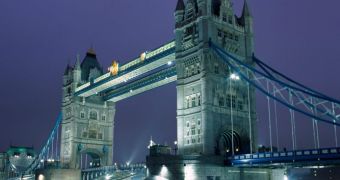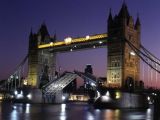It is perhaps the most worldwide known symbol of England: the Tower Bridge. It is associated with the Tower of London, not to be confused with the London Bridge.
During the 18th and 19th centuries, many bridges were built over Thames. In 1750, the old London Bridge had such a weak foundation and was so narrow that it caused an almost continuous circulation blockage. Ships coming from all over the world crowded to pass below it, to find a place in the busy port.
In 1872, the British parliament analyzed a law project regarding the authorization of the building of a bridge over Thames. At the request of the London Corporation, the city's architect Horace Jones suggested the building of a Gothic style drawbridge, downward from the London Bridge. The new bridge would have allowed ships to navigate up the Thames to the docks located westward. Despite the objections of the governor of the Tower, the Parliament decided to apply the project, on the condition that the bridge style matched that of the Tower of London.
The project was unique because it was the first drawbridge with back balance, inspired by the small drawbridge on the Dutch channels. It was built by means of modern methods, having a steel structure and bricked facade.
The bridge has two master towers united through two pedestrian passages 34 m (113 ft) over the driveway and 42 m (140 ft) over the maximum level of the water. The driveway is interrupted by the two weighs of the back balances. The huge wings of the bridge weigh around 1,200 tons each, and detach from one another, rising at an angle of 86 degrees. Ships up to 10,000 tons can pass safely under the bridge.
A hydraulic mechanism lifts the weighs, controlling an elevator - which takes the pedestrians from the driveway level to the pedestrian passage - and even activates the alarm signal. The power delivered by the water is twice greater than the required amount of energy!
Four boilers heated by coal and installed under the southern head of the bridge produced vapors at a pressure of 5-6 kg (11-13 pounds) per square centimeter, putting into motion two huge pumps. They pumped water at a pressure of 60 kg (133 pound) per square centimeter. In order to have permanently ensured the energy necessary to lift the weighs, water was stocked under pressure in 6 tanks. The tanks fueled with energy the 8 engines controlling the weighs. Once the mechanism started, the back balance weighs raised over a pivot of 50 cm (1.6 ft) in diameter. In just one minute the wings reached the maximum height.
Today the hydraulic power is replaced by electricity. Of course, the road circulation stops when the bridge is lifted. The docks are placed further downwards from the modern metropolis, but the old Docklands still keeps an original architecture.

 14 DAY TRIAL //
14 DAY TRIAL // 
